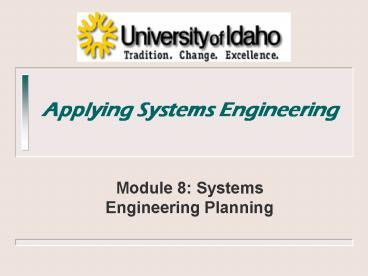Applying Systems Engineering - PowerPoint PPT Presentation
1 / 26
Title:
Applying Systems Engineering
Description:
Identify top-level driving requirements and establish preliminary system ... include taking the lead, under proper direction, in defining organizational ... – PowerPoint PPT presentation
Number of Views:23
Avg rating:3.0/5.0
Title: Applying Systems Engineering
1
Applying Systems Engineering
- Module 8 Systems Engineering Planning
2
Objectives
- Chapter 7 in the Textbook.
- SEMP is introduced but not covered.
- Define the Systems Engineering Management
approaches. - Define the Project Engineering alternatives.
- Discuss tailoring of the Systems Engineering
process. - Discuss the purpose of the Systems Engineering
Management Plan (SEMP).
3
Where are We in theSE Process?
- Objectives
- Plan for the total systems engineering effort on
a project - Integrate with project management activities
4
Key Terminology
- Engineering systems
- Lifecycle options
- System Engineering Management Plan (SEMP)
5
Systems Engineering Planning
- Determines how the systems engineering process is
to be accomplished and controlled to meet project
objectives. - Ensures proper balance of quality, cost,
schedule, risk, and performance. - Provides a tailored integration and coordination
of the project engineering system. - Provides the technical management plan, via the
publication of a Systems Engineering Management
Plan (SEMP), for the integration of all
engineering activities. - "Plans are nothing, planning is everything.
- General Dwight D. Eisenhower
6
Tailoring the Systems Engineering Process
see handout for complete SE Checklist
7
Determining theLevel of Rigor (One Approach)
8
Different Kinds of Development or Lifecycles
- Sequential (waterfall-like)
- Title Design
- DOD
- VEE
- Incremental
- Evolutionary
- EVO
- Spiral
- Rapid Application (Rapid Prototyping)
- Competitive Piloting
- Framework Architecture
- Design-to-Cost
- Re-engineering existing systems
- Reverse Engineering
- Platform Model
9
Classic SE per DOE Project Management Practices
10
DOD Model Waterfall Do it Once, Right
11
Waterfall Generally without the feedback
12
Vee Model with Horizontal Integration
13
Incremental, Model Based System (CrossTalk
article)
14
Evolutionary Development
15
Tom Gilbs EVO ModelEvolutionary Project
Management
16
Spiral Model ClassicNote trail of Prototypes
17
Spiral Model
From Project Management Institute, per Muench
18
Systems Integration Model (Rapid Prototype)
19
Develop Design-To-Cost Objectives
Level 1
Level 2
Level 3
20
Knowledge BasedGAO Report
21
Platform Model
22
Four good lecture series
- http//www.cs.qub.ac.uk/J.Campbell/myweb/misd/mis
d.html - http//medix.marshall.edu/mccarthy/tm660/Lecture_
13_ApplicationDevelopment/Lecture13_SEngg.pdf - http//www.cee.hw.ac.uk/lachlan/islectures/
lectures/softeng.ppt - web.nps.navy.mil/menissen/mn3309/m09l4p4.ppt
23
Comparison of Waterfall, Rapid Prototype and
Spiral
Waterfall Model
Spiral Model
Rapid Prototype Model
24
Define OrganizationalRoles and Responsibilities
- Systems Engineering tasks often include taking
the lead, under proper direction, in defining
organizational roles and responsibilities to
include - Teams
- Integrated Product Teams (IPT) also known as
Concurrent Engineering Teams (CET) or Design
Build Teams (DBT). - May be short or long term
- Usually one IPT for each major product and
integration - Each WBS element should be mapped into an IPT
- Beneficial to create teams that will develop
- products and process with an integrated
- approach to meeting requirements.
- Identification of the Chief or Lead Systems
Engineer. - Identification of responsibilities of other
- Systems Engineers.
- Coordination of SE roles and responsibilities
- with Project Management (PMP and SEMP
- are mutually supportive?).
25
Define, Develop, and Acquire SE Development
Environment (SEDE) and Tools
- The Systems Engineering Development Environment
(SEDE) includes - Processes
- Methods
- Tools
- Environment.
Process
SEMP
Methods
Tools
SEDE
Environment
26
Prepare Systems Engineering Management Plan (SEMP)
- The SEMP is the primary, top-level technical
management document for the integration of all
engineering activities within the context of, and
as an expansion of, the project plan. - Your choice of approach should be documented in
the SEMP































